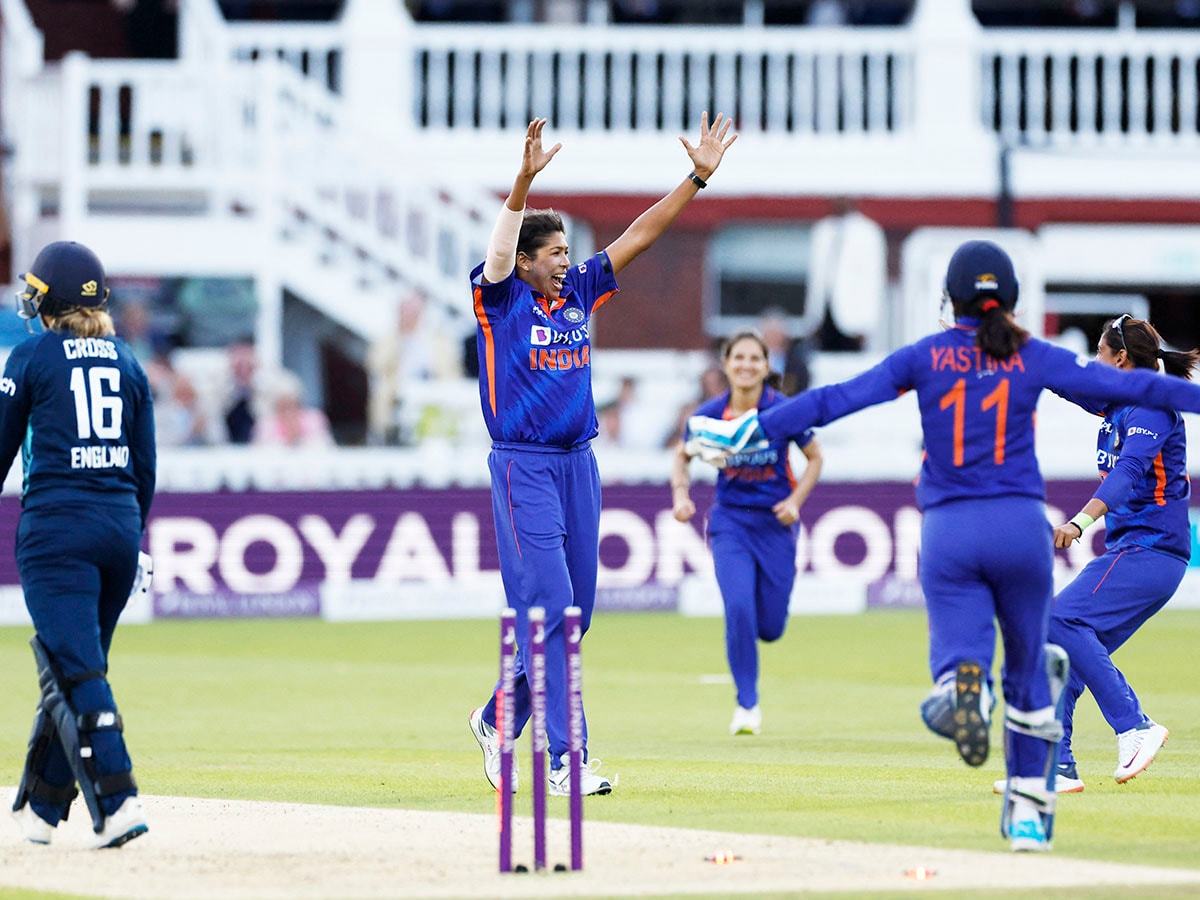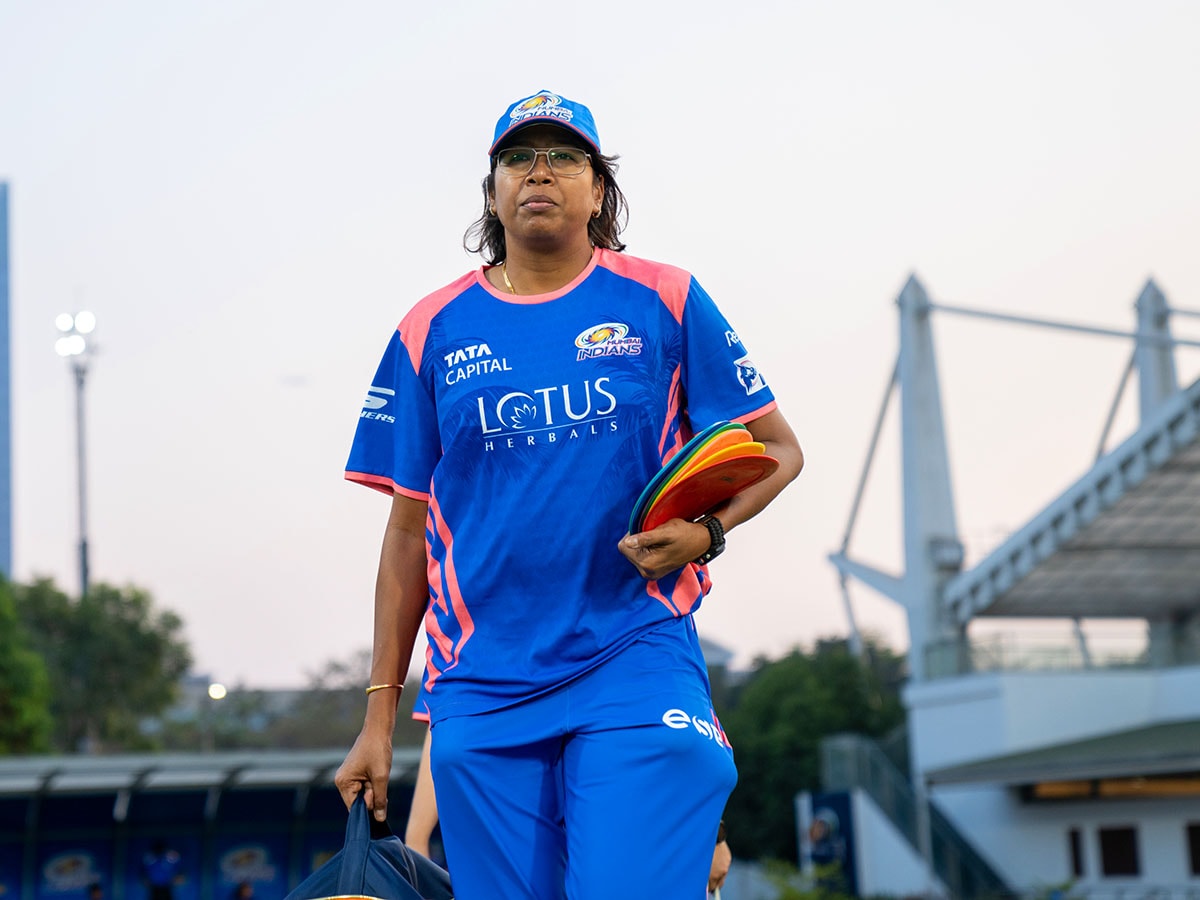The legacy of Goswami, though, continues even in retirement. In her role as the bowling coach and mentor for the Mumbai Indians in the WPL (Women’s Premier League) and the mentor for the Trinbago Knight Riders in the WCPL (Women’s Caribbean Premier League), the former India captain now plays a key role in developing young talent. Add to that the occasional commentary stints, and Goswami is enjoying a rollicking second innings. “The first was better in the sense that it was in my control, while now I’m outside the boundary line. That way, it was easier to play while coaching is a bit more challenging. But I’m enjoying the second innings as well,” she says.
Ahead of the third season of the WPL, Goswami spoke to Forbes India about the league’s impact, why franchise cricket is the vessel of growth for women’s cricket, and what it means to have a stand named after her. Edited excerpts:
It’s something I had never thought of. I’m thankful to the CAB (Cricket Association of Bengal) officials for this. But it’s not just about me, I am representing women’s cricket as a whole. It’s the first time a stand has been named after a woman cricketer [in India]. Not just me and my family, but the entire women’s cricket fraternity was proud of that. As a youngster, I just wanted to be there and play at that historic venue, but with the kind of association the stand has now given me to the Eden Gardens, I couldn’t have asked for more.
Q. But the journey wasn’t easy, because you played women’s cricket at a time when there was hardly any recognition for the game.
At that time, everything was a challenge. When I conveyed to my family my intention to play cricket, none of them knew anything about the game. Hailing from a middle-class family in Chakdaha (in Bengal’s Nadia district), where there were no facilities for girls, the answer was an obvious no. In fact, every day, during my journey from Chakdaha to Kolkata, on the train and on the bus, people used to tease us—“do women play cricket at all” is a question that we would get asked for the entire first half of my career, even when I represented India. But none of us ever paid heed to those questions, we played because of our passion and love for the game.
Q. India’s U-19 cricketers have just won the World Cup. But in sports we often see athletes stumble to bridge the senior-junior divide. What would your advice be for the young girls to seamlessly transition to the senior stage?
There is a huge gap between the two levels and one has to work very hard to bridge the gap. Day by day, we see ruthlessness coming into women’s cricket—there’s greater exposure now, as a result the competition levels are rising. All these players have to learn to be ruthless on the field. For that, one has to prepare. If you play a match against a team like Australia, they won’t give away anything—you have to earn it. And you can do it only through intense preparation. These girls will also have to know that there are no shortcuts—in modern cricket, with so much technology and data scrutinising your game, you will be exposed very quickly if you cover up your chinks with shortcuts.
Also read: Don’t fear pressure, deal with it: Jhulan Goswami
Q. The third edition of the WPL is about to start. How has the league changed the women’s game in India?
Let me give you the example of MI’s Sajeevan Sajana. In her very first match last year [against Delhi Capitals], playing under a pressure situation of needing five runs in one ball, she hit a sixer to help us win. While Sajana was doing this for her state team for several years, WPL has given her the platform for instant recognition. Earlier, no one watched women’s cricket, matches weren’t being televised. When she hit that six in front of a packed stadium, it changed the course of her career—she got to represent India, she played in the World Cup.
 With 255, Goswami has the most number of international wickets in the women’s game Image: Reuters/Peter Cziborra
With 255, Goswami has the most number of international wickets in the women’s game Image: Reuters/Peter Cziborra
Q. The MI dressing room has two legends—you and [head coach] Charlotte Edwards. How do you channel your combined international experiences to marshal the team?
Charlotte is a fantastic leader. I’ve known her from her playing days and we bonded even during that time. Working with her now is a huge learning experience for me since she has been coaching franchise teams from before me. The beauty about her is she tries to bring everyone together. In a tournament like WPL, team-building is important because you play with players who come to you through an auction, [unlike national teams where they are automatically selected]. We try to keep the dressing room a happy place so that they can express themselves on the field. The MI motto is to play fearless cricket and we ensure they stick to that.
Q. There are a number of women’s franchise leagues around the world now. Should these be the vehicle to grow women’s cricket?
Yes, I absolutely believe that. Tell me how many matches were televised before these franchise leagues like WPL came into being, how many people would come to the stadium? With franchise leagues, the viewership has risen, there has been financial support greater than what players get from bilateral series. What many players earn from a single season of WPL is higher than what they get from a single year of the BCCI contract. I have said it before and I will reiterate that the ICC should schedule the cricket calendar in a way that all the franchise leagues get a proper window and all the international players are available for those competitions. This is the way forward for women’s cricket.
Q. As part of your franchise and the Bengal team, you mentor a lot of young cricketers now. In terms of their attitude and approach towards the game, how different are they from those during your time?
One difference is that they are very aware. They are technology-friendly, unlike us who found technology to be a bit of a challenge. So, if they are playing somewhere, Google will give them all the details about a venue, wicket conditions, average score, what’s a winning score, what have you. This is a distinct advantage they have, but this can turn into a disadvantage too if you lose focus. Since we didn’t have these details at the tip of our fingers, we used to prepare hard to make sure we could survive in whatever the conditions were. But when you have all the information, one can tend to adopt shortcuts. And you can never progress if you take shortcuts. You have to come out of your comfort zone and improve your skills; only then can you survive over a long time.
Q. The national team has had a middling year in 2024, with a disappointing exit from the T20 World Cup. With the ODI World Cup scheduled at home this year, what does the team need to do to turn around?
I haven’t been following international cricket that well since my retirement. I’ve been busy with my franchise duties as well as the Bengal team. All I can say is that preparation has to be top notch and the core group has to take the team ahead.
 Jhulan Goswami, former India pace spearhead, and the mentor and bowling coach of the Mumbai Indians Image: Mumbai Indians
Jhulan Goswami, former India pace spearhead, and the mentor and bowling coach of the Mumbai Indians Image: Mumbai Indians 
